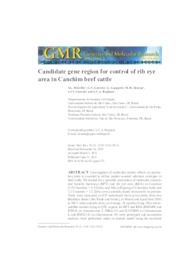Candidate gene region for control of rib eye area in Canchim beef cattle.
Candidate gene region for control of rib eye area in Canchim beef cattle.
Author(s): MEIRELLES, S. L.; GOUVEIA, G. V.; GASPARIN, G.; ALENCAR, M. M. de; GOUVEIA, J. J. S.; REGITANO, L. C. de A.
Summary: Investigation of molecular marker effects on production traits is essential to define marker assisted selection strategies in beef cattle. We looked for a possible association of molecular markers and backfat thickness (BFT) and rib eye area (REA) in Canchim (5/8 Charolais + 3/8 Zebu) and MA (offspring of Charolais bulls and 1/2 Canchim + 1/2 Zebu cows) animals raised exclusively on pasture. Traits were measured on 987 individuals from seven herds from two Brazilian States (São Paulo and Goiás), in March and April from 2005 to 2007, when animals were, on average, 19 months of age. Five microsatellite markers lying in QTL regions for BFT and REA (BMS490 and ETH10 on chromosome 5, INRA133 and ILSTS090 on chromosome 6, and BMS2142 on chromosome 19) were genotyped and association analyses were performed under an animal model using the restricted Candidate gene region for control of rib eye area maximum likelihood method. After correction for multiple tests, a significant effect of microsatellite BMS490 on REA was observed, suggesting that at least one QTL affecting carcass traits in this region of the BTA5. No significant effect on BFT was observed for these markers.
Publication year: 2011
Types of publication: Journal article
Keywords: Association study, Carcass traits, Microsatellite markers, cattle
Observation
Some of Embrapa's publications are published as ePub files. To read them, use or download one of the following free software options to your computer or mobile device. Android: Google Play Books; IOS: iBooks; Windows and Linux: Calibre.
Access other publications
Access the Agricultural Research Database (BDPA) to consult Embrapa's full library collection and records.
Visit Embrapa Bookstore to purchase books and other publications sold by Embrapa.

